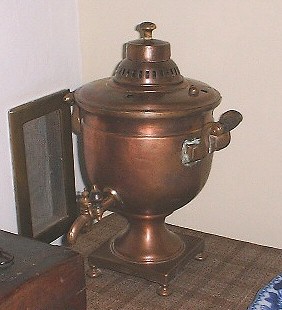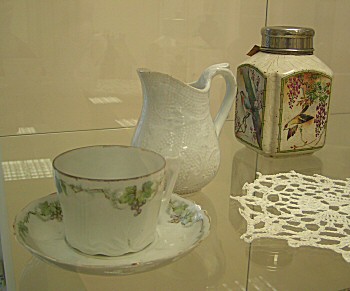Message
Tea History
Russian Tea History
In 1567, Cossack atamans (chieftains), Petrov and Yalyshev, visited China, where they tried a local drink — tea. In 1638, an ambassador, Vasily Starkov, brought a present to the Russian Tsar from one of the Mongol khans — 64 kg of tea. In 1665, when the Tsar Alexey Mikhaylovich got stomach aches, the court doctor, Samoylo Kallins, treated him with tea. In 1728, between the Kyakhta River and Mount Oratoga (Siberia) settlement Kyakhta appeared, which later developed into a city and became the centre of the Russian-Chinese trade. In 1763, in Kyakhta, the fair was established; there Russian and Chinese merchants cheated each other without losing mutual respect. Russia got most of Chinese tea through this very fair — tsybiki (tea chests for 25-35 kilos of tea) with tea were brought to the European part of Russia on sleigh…I started the ‘russian tea history’ part with a ‘chronological’ paragraph intentionally. It was necessary to enumerate the aforementioned facts for the sake of historical scrupulosity and nothing more, because they took place long ago and we have nothing to do with them anymore. Everything described below is of more interest…
Tea was brought to Russia from Northern China, where it was called ‘cha-i’ or ‘cha-e’, that is why in Russia the drink got the name ‘chay’ (tea). Originally, though, in Russian records, tea was often called ‘the Chinese herb’ or ‘the Chinese dry herb’. Two kinds of tea were brought from China: brick-tea and loose tea (baykhovy). The etymology of the word ‘baykhovy’ is connected with the Chinese ‘bai hoa’ (‘white eyelash’). According to the most wide-spread version, Chinese merchants called so tea with a large amount of tea tips — bud leaves on a tea bush. Russian merchants applied this term for any non-brick tea.
During quite a long time, Russian women did not drink tea — they preferred traditional drinks to a hot and non-sweet foreign one. Russian Orthodox Church did not accept the drink at once either. However, as early as in the 18th century, tea became an indispensable attribute of the monastic life — monks appreciated the ability of tea to sustain spiritual and physical strength.
 |
||
| Samovar from Pushkin museum house (Pushkinskiye Gory). | ||
By the beginning of the 19th century, tea had become an essential part of noble life — adopting French and English habits, Russian noblemen willingly treated themselves to tea, adding some Russian coloring to the European tea drinking. By 1820, the set of rules and customs, called Russian tea tradition, generally had formed — though tea was still too expensive to become a mass drink. In the 1820s wholesale trade in tea concentrated at Makaryev fair (later it moved to Nizhny Novgorod), where a special clan of tradesmen (called ‘chayniki’ — literally ‘teapots’ employed to mean ‘tea-traders’), appeared. Over 40 years (until the 1860s), tea was a backbone article of trade at the fair — prices for any other goods were fixed only when the price for tea had been declared.
In 1833, first tea plantations appeared in Georgia (I consider this fact a part of Russian tea history as Georgia was part of the Russian Empire and later of the Soviet Union for quite a long time). Prince Mikha Eristavi was a pioneer of Georgian tea-growing — in 1864, at the All-Russian Agricultural Exhibition in St-Petersburg, he presented the first tea that was plucked and produced on the territory of the Russian Empire. Eristavi’s initiative surprised people, but it did not arouse much enthusiasm and did not receive the support of the government. Until the 1920s, Georgian tea-growing remained the lot of individual enthusiasts. Through their effort, in 1865, in Chakva (Adzharia) first industrial tea gardens were founded.
In 1869, the opening of the Suez Canal made shipping of tea to Russia more profitable and prompt — as a consequence, by 1875, Odessa had become the ‘tea gate’ of the country. At the same time, Odessa became the centre of tea falsification. They did it on Malaya Arnautskaya Street. Very often tea was falsified in quite radical methods — by adding metal filings, for example. For the weight’s sake. The spreading of falsified tea in Ukraine may explain the fact that tea drinking did not take root in that region — it is not improbable that they just could not find good tea in Ukraine at that time.
In 1877 tea was introduced into the ration of the Russian Army. From 1886, through peaceful time, tea completely replaced the ‘wine portion’. The popularity of tea was constantly growing, and by the end of the century, it started being mentioned in contracts as a means of payment. On 28th August 1882 in St-Petersburg, the first official tea-room was opened. Tea-rooms were allowed to open at 5 o’clock in the morning — one hour earlier than pubs. That is why cab drivers, being representatives of one of the ‘morning’ trades, became the haunters of tea-rooms.
 |
||
| Old russian porcelain. | ||
The last pre-revolution point of the Russian tea history is 1900. That year, the Trans-Siberian Railway was launched (its construction was completely finished in 1916). The Railway was fatal for Kyakhta, which during one and a half century was prospering on tea trade. The transportation of tea by this road made the drink rather cheap and properly mass in Russia (in all fairness, even in the ‘cheapest’ times, in Russia tea was thrice as expensive as in England).
After 1917, according to what Pokhlyobkin says in one of his works, there arose a strange situation with tea in this country. The territory of Russia controlled by the Red forces had large old stores of tea. This tea was often given to people for free in the army, for example, or at works. The White, on the contrary, controlled the territory with scarce or no tea supplies and no tradition of tea drinking. That’s why they drank vodka and that’s why they lost (I am not at all sure that the role of tea in the Russian Civil War was all that important).
By the way, the distribution of tea during the Russian Civil War was done by the institution with a proud name Centrochai (i.e. ‘Tea Central’). In 1920s in Soviet Russia, the adopted program of tea industry development staked on Georgia. Before the war, some English experts had time to go there. They said that tea would not grow in Georgia. But it did grow. Not only in Georgia. In 1930s tea industry was launched in Azerbaijan, in 1937 Azerbaijan tea became available for sale. Krasnodar Territory was also ready to pass from experiments to industrial production, but this had not happened until 1948-49.
After the war, the party and government under the leadership of Comrade Stalin himself pursued a course of tea independence of the USSR. They attempted growing tea in Ukraine, Kazakhstan, and Uzbekistan. The Georgian tea industry achieved increasingly better pace of work; and at the end of 1950s, there came its golden age — not for long though.
 |
||
| Classic russian samovar. | ||
13th May 1958, in the collective farm of the village Chaniyeti, the first tea-plucking machine began to work; at that time it was considered as an unambiguous success. The point is that foreign experts declared the absolute impossibility of high-quality mechanized tea plucking. Some Western bank even instituted a prize of ₤100 000 to the inventor of the first tea-plucking machine. It is quite possible that the reason for the invention of the machine was the desire to get the better of the West, which was a strong argument during the rule of Nikita Sergeyevich Khrushchev. By the way, his inventors were not paid ₤100 000 — which gave rise to a certain amount of caustic remarks in the Soviet press.
In 1970, for the first time in several centuries, the supplies of tea from China were cut off — due to political discrepancy between the two countries. Soviet tea industry could not meet the demand in full — the USSR began to import tea from India and Sri-Lanka. Our citizens appreciated Indian and Ceylon teas, and they forgot Chinese teas very quickly — nowadays, the share of Chinese teas in the Russian tea market is hardly higher than 5%.
In 1980, the Georgian tea industry began to degrade. Inefficiency of machine tea-plucking, exhaustion of the soil, which they tried to compensate by means of chemical fertilizers, and a huge amount of organizational problems led to the drop in quality and quantity of Georgian tea. These very problems also spoiled tastes of Russian tea consumers. Since it was problematic to make a strong drink out of Georgian tea, the tea which could be brewed the strongest was recognized the tea quality summit . This exclusively psychological point resulted in the crazy popularity of СTС-tea, which appeared in Russia in the early or mid 1980s (in strict confidence I can notice that СTС-tea is almost always worse than loose tea — but it does make a stronger drink).
The latest part of Russian tea history began in the mid 1990s. I will wait a little with its description as it is not over yet ;)
Denis Shumakov